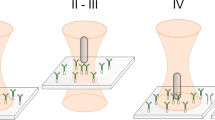Abstract
Atomic force microscopy (AFM) is being increasingly used to directly measure protein interactions in nearly physiological environments. Here, protocols for atomic force microscopy (AFM) for visualization of antigen–antibody complexes are presented. The technique is used to demonstrate complexes formed by rheumatoid arthritis patient antibodies with lipopolysaccharide (LPS) isolated from P. mirabilis (O3) strain S1959 and a synthetic antigen (LPS epitope of 6 N-alpha-(D-galacturonoyl)-L-lysine residues).
Access this chapter
Tax calculation will be finalised at checkout
Purchases are for personal use only
Similar content being viewed by others
References
Grieshaber D, MacKenzie R, Vörös J, Reimhult E (2008) Electrochemical biosensors - sensor principles and architectures. Sensors 8(3):1400–1458
Volkov D, Strack G, Halámek J, Katz E, Sokolov I (2010) Atomic force microscopy study of immunosensor surface to scale down the size of ELISA-type sensors. Nanotechnology 21(14):145503
Corry B, Uilk J, Crawley C (2003) Probing direct binding affinity in electrochemical antibody-based sensors. Anal Chim Acta 496:103–116
Waritani T, Chang J, McKinney B, Terato K (2017) An ELISA protocol to improve the accuracy and reliability of serological antibody assays. MethodsX 4:153–165
Dufrêne YF, Hinterdorfer P (2008) Recent progress in AFM molecular recognition studies. Pflügers Arch 456(1):237–245
Zhengjian L, Wang J, Chen G, Deng L (2010) Probing specific interaction forces between human IgG and rat anti-human IgG by self-assembled monolayer and atomic force microscopy. Nanoscale Res Lett 5(6):1032–1038
Gleńska-Olender J, Sęk S, Dworecki K, Kaca W (2015) A total internal reflection ellipsometry and atomic force microscopy study of the interaction between Proteus mirabilis lipopolysaccharides and antibodies. Eur Biophys J 44(5):301–307
Kaca W, Knirel YA, Vinogradov EV, Kotełko K (1987) Structure of the O-specific polysaccharide of Proteus mirabilis S1959. Arch Immunol Ther Exp 35(4):431–437
Gromska W, Mayer H (1976) The linkage of lysine in the O-specific chains of Proteus mirabilis 1959. Eur J Biochem 62(2):391–399
Gleńska-Olender J, Durlik K, Konieczna I, Kowalska P, Gawęda J, Kaca W (2017) Detection of human antibodies binding with smooth and rough LPSs from Proteus mirabilis O3 strains S1959, R110, R45. Antonie van Leeuwenhoek 110(11):1435–1443
Żarnowiec P, Czerwonka G, Kaca W (2017) Fourier transform infrared spectroscopy as a tool in analysis of Proteus mirabilis endotoxins. Methods Mol Biol 1600:113–124. https://doi.org/10.1007/978-1-4939-6958-6_11
Chernyak AY, Kononov LO, Kochetkov NK (1994) Glycopolymers from synthethic fragments (amides of α-D-galacturonic acid with amino acids) of Proteus O-antigens. J Carbohydr Chem 13(3):383–396
Agilent Technologies 5500 Scanning probe microscope user’s guide. Agilent Technologies, Inc. 2008
Acknowledgments
The presented studies were supported by grant “Preludium 8, UMO-2014/15/N/NZ6/02505,” National Research Center, Poland for JG-O, and BS 2018 UJK for WK.
Author information
Authors and Affiliations
Corresponding author
Editor information
Editors and Affiliations
Rights and permissions
Copyright information
© 2019 Springer Science+Business Media, LLC, part of Springer Nature
About this protocol
Cite this protocol
Kaca, W., Gleńska-Olender, J., Konieczna, I., Gawęda, J., Sęk, S. (2019). Assessment of Proteus mirabilis Antigen Immunological Complexes by Atomic Force Microscopy. In: Pearson, M. (eds) Proteus mirabilis. Methods in Molecular Biology, vol 2021. Humana, New York, NY. https://doi.org/10.1007/978-1-4939-9601-8_23
Download citation
DOI: https://doi.org/10.1007/978-1-4939-9601-8_23
Published:
Publisher Name: Humana, New York, NY
Print ISBN: 978-1-4939-9600-1
Online ISBN: 978-1-4939-9601-8
eBook Packages: Springer Protocols




